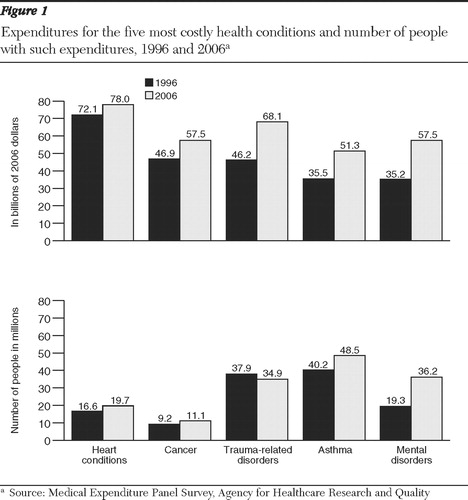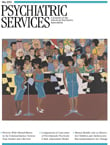U.S. Spending on Mental Illness Soars as Number of Treatment Seekers Nearly Doubles
Between 1996 and 2006 spending on the diagnosis and treatment of mental illnesses grew at a faster pace than spending on other health conditions, according to a statistical brief issued by the Agency for Healthcare Research and Quality. During the same period, the number of Americans who sought treatment for depression, bipolar disorder, and other mental disorders almost doubled, outpacing increases among patients seeking treatment for other conditions.
In 1996 and 2006 the same five conditions ranked highest in terms of direct medical costs: heart conditions, cancer, trauma-related disorders (injuries and burns), mental disorders, and asthma. As shown in Figure 1 , spending for all five conditions increased over the ten-year period (p≤.05 for all). For mental disorders, spending rose from $35 billion (in 2006 dollars) to almost $58 billion. Figure 1 also shows the number of people with expenditures associated with the five conditions. For mental disorders the number rose from 19 million people in 1996 to more than 36 million in 2006.

In both years mean per-patient costs were highest for cancer, $5,067 in 1996 and $5,176 in 2006, and for heart conditions, $4,333 and $3,964, respectively. Similar to the trend for heart disease, per-patient costs fell for mental disorders, from $1,825 in 1996 to $1,591 in 2006. Trauma-related per-patient costs showed the greatest dollar increase, from $1,220 to $1,953. Asthma had the lowest mean expenditures per person in both 1996 and 2006—$883 and $1,059, respectively.
Out-of-pocket expenses in both years were highest for mental disorders (23% of total spending on mental disorders in 1996 and 25% in 2006), followed by asthma care (15% and 17%, respectively). In 1996 the out-of-pocket share was lowest for cancer treatment, at 3.8%. In 2006 heart disease replaced cancer as the condition with the lowest out-of-pocket costs, at 8.2%.
Data for the statistical brief are from the Medical Expenditure Panel Survey (MEPS). The Five Most Costly Conditions, 1996 and 2006: Estimates for the U.S. Civilian Noninstitutionalized Population is available at meps.ahrq.gov/mepsweb/data_files/publications/st248/stat248.pdf .



